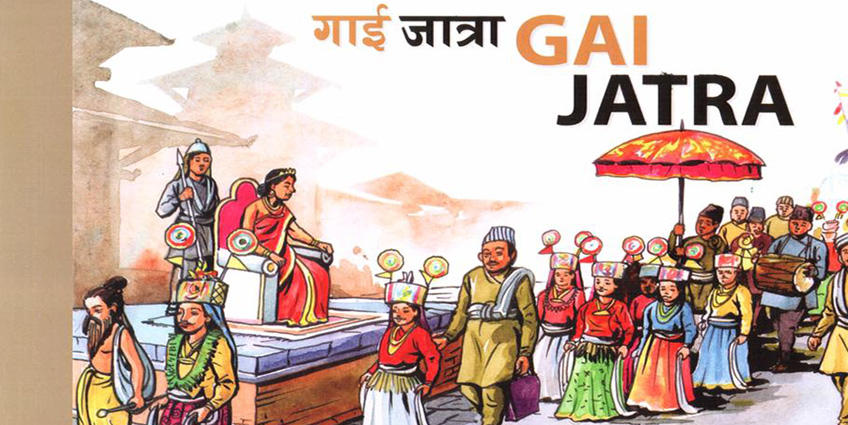Gai Jatra Festival: The cow festival where death is accepted as a part of life
August 19, 2016 admin

In a nation of geographical extremes and cultural diversity, you have another festival that’s a must in your list. This festival is named Gai Jatra, the cow festival where relatives of the deceased take out a procession in memory of their relatives who lost their life in the past year. Named after cow, a holy animal in Hindu religion, participants (mostly from Newar community and especially in the Kathmandu valley) believe that such procession led by cow (substituted by boy decorated as the animal) in this festival helps the spirits of their lost dead enter into heaven. In other words, people accept death as a part of life through this festival.
The History
Though the modern form of Gai Jatra is said to have started since the medieval age, in the Malla era, from Kathmandu, its history can be traced back to ancient period when the locals of Kathmandu worshipped Lord Yamaraj, the God of Death. Legend has it that, in the 17th century when King Pratap Malla couldn’t make his grief-stricken wife accept the death of their young son and make her smile, he ordered his people for carrying out procession to make his queen laugh. Exuberant people performed in the procession, ridiculed the rich and highlighted the plight of the poor with no mercy spared. This made the queen laugh and the delighted king ordered the inclusion of laughter, satire, mockery and humor in the festival.
The tradition has passed on for generations till now, with some modifications and transformations owing to the then social and other reasons. Now you want to find out how is this festival actually celebrated, right? Read on.
The Celebration and procession
A festival celebrated by the Newar community, mostly in the Kathmandu valley, Gai Jatra, as the name goes, is a festival of cows. The procession begins from the houses of people who has lost someone in the past year and following a route, gather in the local Durbar Squares of the respective cities through to other localized areas within the city where it is celebrated.
The procession has to have a cow, a holy animal in Hindu religion, at the front or a boy as the substitution, and the family and relatives thereafter. Boys are draped in colorful clothes and paper headdress as well as white loin clothes and loose saffron vests. If a family has lost a female member, the boys are dressed as girls in the procession. During the procession, other relatives and friends assist by distributing fruits, sweets, milk and beaten rice to the participants. In short, people commemorate their deceased loved ones, share others’ grief and accept that death is nothing but a part of life.
Different cities have different way of celebration
While this picturesque festival began from Kathmandu, over the time it spread over to other cities of Kathmandu such as Patan, Kirtipur and Bhaktapur. While each city has some variations in the way of celebration, Bhaktapur has the most enjoyable one.
Bhaktapur celebrates Gai Jatra for 8 days and 9 nights which begin with the Ghinsang Ghisi dance and continues until the Krishna Astami festival. Local youths are there with traditional instruments and cultural dances which are preceded by Taha Macha, a bamboo chariot wrapped by a white cloth or Haku Patasi (a traditional Newari dress for women) depending on whether the deceased was male or female. In the centre of this bamboo chariot is the photo of the deceased person. The festival concludes with a bhoj or party.
Patan celebrates this festival with less fanfare, yet the ways of celebration closely matches with that of Kathmandu. Kirtipur, a unique ancient city celebrates Gai Jatra Festival in different way due to the blend of different beliefs. Here the locals dress themselves in the form of different gods and goddesses instead of dressing up themselves as cow or other animal. They believe that the door to heaven opens up on this day and their procession helps their deceased relatives to reach the gates of heaven.
Gai Jatra and the freedom of expression
What started in the medieval age as the attempt to make the sad queen of King Pratap Malla laugh has over the centuries transformed as an opportunity to utilize the freedom of expression. Wrapped up in humor, satire, comedy acts and shows, artists and locals have been using this festival to ridicule government, its agencies and officials and social evils. They enjoyed the liberty of expression even during the strict regimes of Shah Dynasty. The tradition continues even today and different shows are organized where artists mock on various issues of daily life and national importance without being reprimanded for such satire and mockery.
So, try to stay in Kathmandu valley if you happen to be here during the Gai Jatra festival. You get to realize the reality of life and learn to accept the grievances of life happily. Enjoy the rich cultural heritage of Kathmandu in this festival of commemoration, humor and philosophy of life. Happy Gai Jatra folks!










